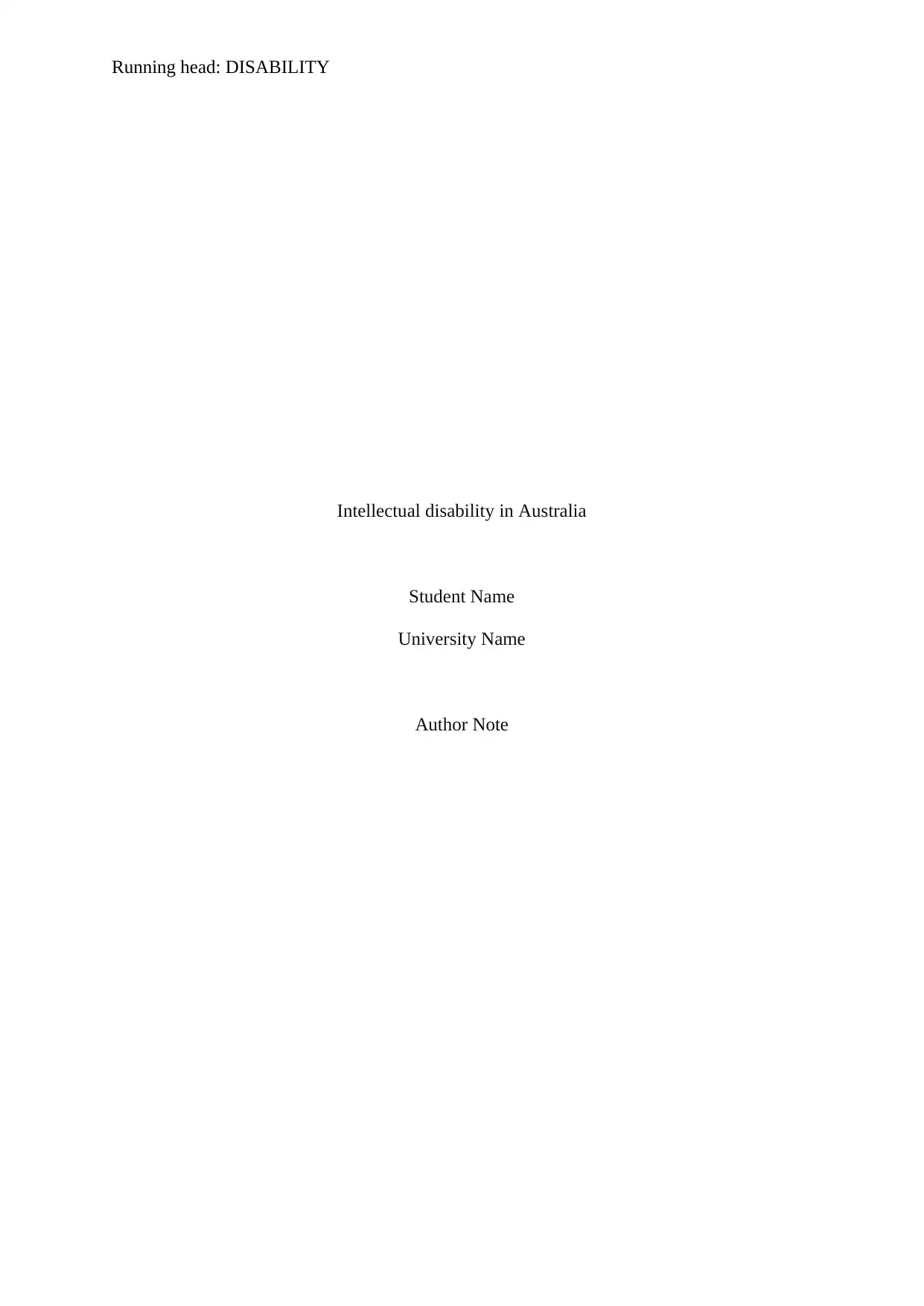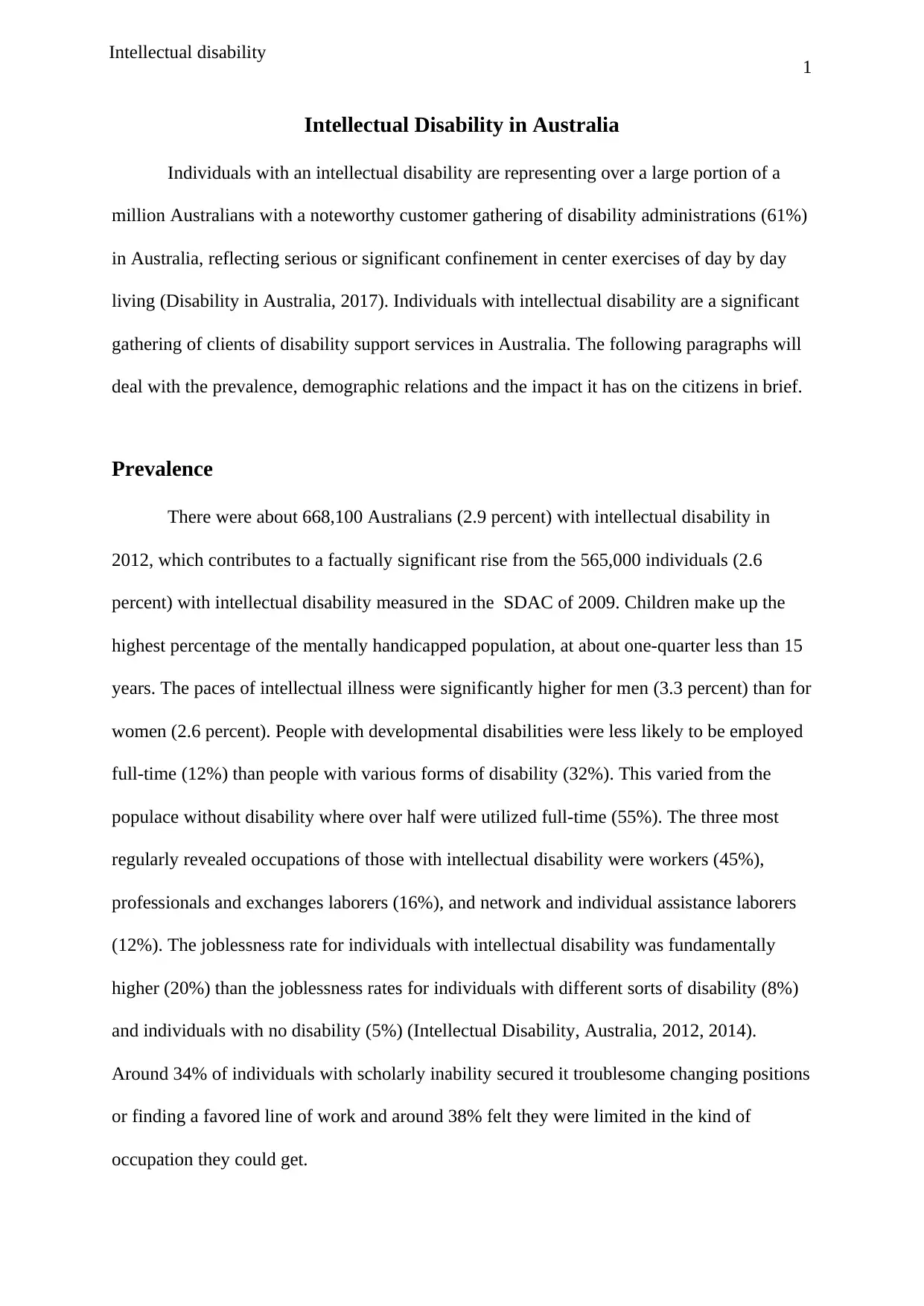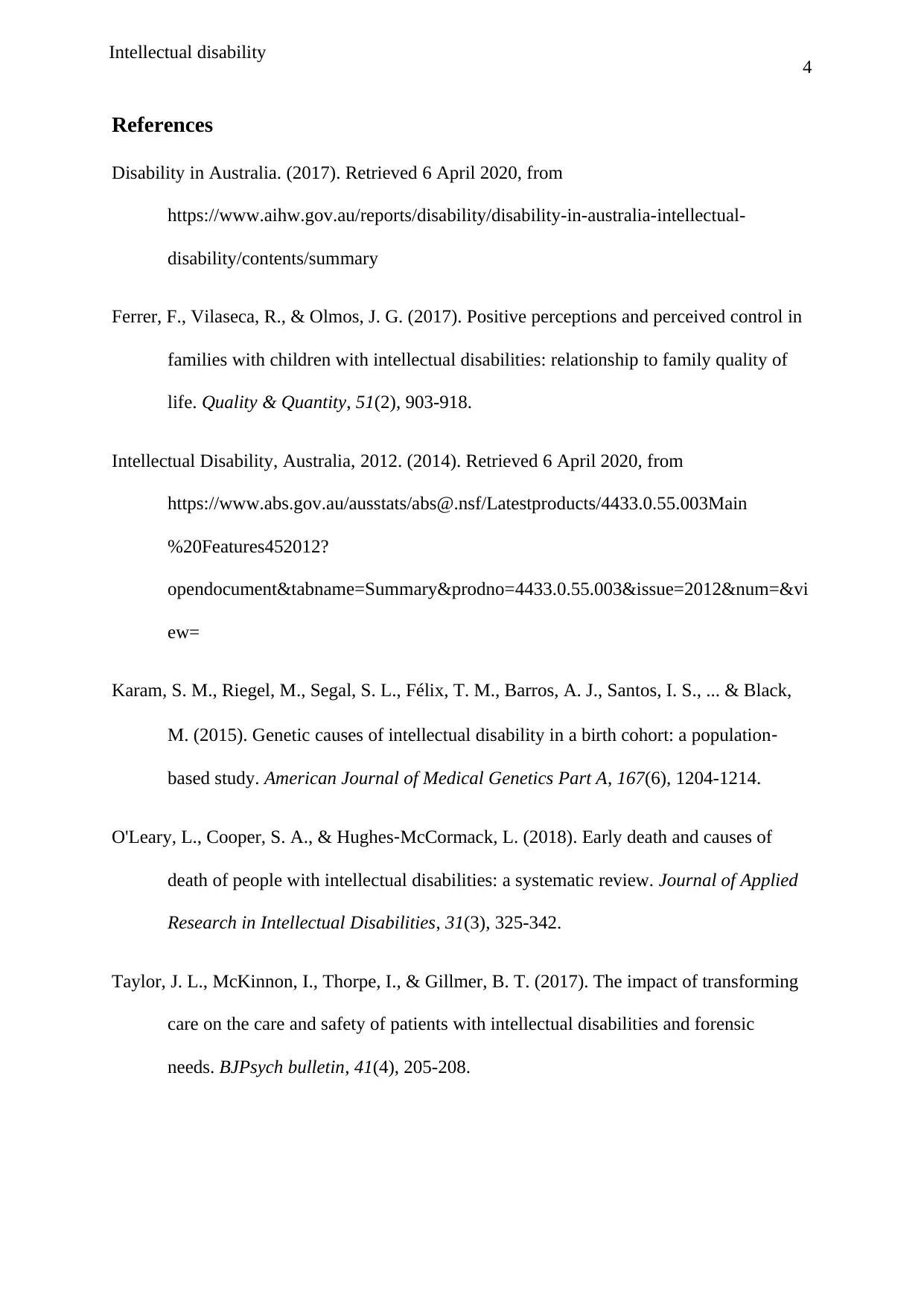Intellectual Disability in Australia: Causes, Impacts, and Statistics
VerifiedAdded on 2022/09/08
|5
|1211
|17
Report
AI Summary
This report provides an overview of intellectual disability in Australia, focusing on its prevalence, causes, and societal impact. It begins by highlighting the significant number of Australians affected by intellectual disability and their reliance on disability services. The report then delves into the prevalence rates, noting a rise between 2009 and 2012, with a higher incidence among males. It explores the causes, including chromosome abnormalities and trauma before or during birth, and the impact on employment, with lower full-time employment rates and higher unemployment rates compared to those without disabilities. The report also discusses the challenges faced by individuals with intellectual disabilities in finding and maintaining employment. The report concludes by emphasizing the need for early intervention and adequate support to enable individuals with intellectual disabilities to live meaningful lives in the community. References to relevant studies and statistics support the findings.

Running head: DISABILITY
Intellectual disability in Australia
Student Name
University Name
Author Note
Intellectual disability in Australia
Student Name
University Name
Author Note
Paraphrase This Document
Need a fresh take? Get an instant paraphrase of this document with our AI Paraphraser

1
Intellectual Disability in Australia
Individuals with an intellectual disability are representing over a large portion of a
million Australians with a noteworthy customer gathering of disability administrations (61%)
in Australia, reflecting serious or significant confinement in center exercises of day by day
living (Disability in Australia, 2017). Individuals with intellectual disability are a significant
gathering of clients of disability support services in Australia. The following paragraphs will
deal with the prevalence, demographic relations and the impact it has on the citizens in brief.
Prevalence
There were about 668,100 Australians (2.9 percent) with intellectual disability in
2012, which contributes to a factually significant rise from the 565,000 individuals (2.6
percent) with intellectual disability measured in the SDAC of 2009. Children make up the
highest percentage of the mentally handicapped population, at about one-quarter less than 15
years. The paces of intellectual illness were significantly higher for men (3.3 percent) than for
women (2.6 percent). People with developmental disabilities were less likely to be employed
full-time (12%) than people with various forms of disability (32%). This varied from the
populace without disability where over half were utilized full-time (55%). The three most
regularly revealed occupations of those with intellectual disability were workers (45%),
professionals and exchanges laborers (16%), and network and individual assistance laborers
(12%). The joblessness rate for individuals with intellectual disability was fundamentally
higher (20%) than the joblessness rates for individuals with different sorts of disability (8%)
and individuals with no disability (5%) (Intellectual Disability, Australia, 2012, 2014).
Around 34% of individuals with scholarly inability secured it troublesome changing positions
or finding a favored line of work and around 38% felt they were limited in the kind of
occupation they could get.
Intellectual disability
Intellectual Disability in Australia
Individuals with an intellectual disability are representing over a large portion of a
million Australians with a noteworthy customer gathering of disability administrations (61%)
in Australia, reflecting serious or significant confinement in center exercises of day by day
living (Disability in Australia, 2017). Individuals with intellectual disability are a significant
gathering of clients of disability support services in Australia. The following paragraphs will
deal with the prevalence, demographic relations and the impact it has on the citizens in brief.
Prevalence
There were about 668,100 Australians (2.9 percent) with intellectual disability in
2012, which contributes to a factually significant rise from the 565,000 individuals (2.6
percent) with intellectual disability measured in the SDAC of 2009. Children make up the
highest percentage of the mentally handicapped population, at about one-quarter less than 15
years. The paces of intellectual illness were significantly higher for men (3.3 percent) than for
women (2.6 percent). People with developmental disabilities were less likely to be employed
full-time (12%) than people with various forms of disability (32%). This varied from the
populace without disability where over half were utilized full-time (55%). The three most
regularly revealed occupations of those with intellectual disability were workers (45%),
professionals and exchanges laborers (16%), and network and individual assistance laborers
(12%). The joblessness rate for individuals with intellectual disability was fundamentally
higher (20%) than the joblessness rates for individuals with different sorts of disability (8%)
and individuals with no disability (5%) (Intellectual Disability, Australia, 2012, 2014).
Around 34% of individuals with scholarly inability secured it troublesome changing positions
or finding a favored line of work and around 38% felt they were limited in the kind of
occupation they could get.
Intellectual disability

2
Causes
The doctors who are responsible for giving the treatment to the people who are diagnosed
with intellectual disability are unable to identify a substantial cause for intellectual disability.
However, some of the causes can be observed as chromosome abnormalities like Down’s
syndrome or lead and mercury poisoning (Karam et al., 2015). In addition to these causes,
trauma before or during birth has also been observed to cause intellectual disability in the
baby (O'Leary, Cooper & Hughes‐McCormack, 2018). Some of the traumas that are
subjected for the child to be experiencing are infection, oxygen deprivation or premature
delivery. These causes have been observed to be one of the driving factors for the subsequent
development of intellectual disability in a child. After thorough research by some authors, it
could be understood that inherited disorders from the parents of the child, that is, Tay-Sachs
disease or phenylketonuria are some of the disorders which have been known to cause
intellectual disability in individuals. One can also understand the sustaining a brain injury in
the early age of the child could also be one of the reasons why they are suffering from
intellectual disability.
Impact
The impacts of intellectual disabilities are dramatically increasing among people who
have them, just as the skill spectrum fluctuates impressively for all people. Of example,
dressing or eating can take more time of children to work out how to talk, walk and cope with
their own needs. This can take longer for students with an intellectual disability to succeed at
school (Taylor et al., 2017). For teenagers, others will have the luxury of providing free
existences in the network without financial assistance, and some may require tremendous
help for the remainder of their lives. In reality, any extent of those with mental disabilities
may have real, deep-rooted limitations in their life. Be that as it might, each person with
Intellectual disability
Causes
The doctors who are responsible for giving the treatment to the people who are diagnosed
with intellectual disability are unable to identify a substantial cause for intellectual disability.
However, some of the causes can be observed as chromosome abnormalities like Down’s
syndrome or lead and mercury poisoning (Karam et al., 2015). In addition to these causes,
trauma before or during birth has also been observed to cause intellectual disability in the
baby (O'Leary, Cooper & Hughes‐McCormack, 2018). Some of the traumas that are
subjected for the child to be experiencing are infection, oxygen deprivation or premature
delivery. These causes have been observed to be one of the driving factors for the subsequent
development of intellectual disability in a child. After thorough research by some authors, it
could be understood that inherited disorders from the parents of the child, that is, Tay-Sachs
disease or phenylketonuria are some of the disorders which have been known to cause
intellectual disability in individuals. One can also understand the sustaining a brain injury in
the early age of the child could also be one of the reasons why they are suffering from
intellectual disability.
Impact
The impacts of intellectual disabilities are dramatically increasing among people who
have them, just as the skill spectrum fluctuates impressively for all people. Of example,
dressing or eating can take more time of children to work out how to talk, walk and cope with
their own needs. This can take longer for students with an intellectual disability to succeed at
school (Taylor et al., 2017). For teenagers, others will have the luxury of providing free
existences in the network without financial assistance, and some may require tremendous
help for the remainder of their lives. In reality, any extent of those with mental disabilities
may have real, deep-rooted limitations in their life. Be that as it might, each person with
Intellectual disability
⊘ This is a preview!⊘
Do you want full access?
Subscribe today to unlock all pages.

Trusted by 1+ million students worldwide

3
intellectual disability will live a wonderful, meaningful life in the network with early
intervention, adequate care and education as an adult. Such disabilities have a substantial
social and financial effect, especially in view of the fact that they can be compounded by
family-level psychiatric disorders, alienation, devastating health costs that are not borne by
the State due to the lack of all-inclusive access to medical care and possibly, most
importantly, the lack of proper social management, ultimately instructive projects (Ferrer,
Vilaseca & Olmos, 2017). In fact, people with intellectual disabilities are at higher risk of
developing problems of physical and mental well-being and are powerless against chronic
illness at an younger age, among multiple factors, due to the high incidence of sedentary
lifestyle.
Conclusion
In concluding remarks, it can be understood that the prevalence of intellectual
disability among the citizens of Australia has been on the rise which have created negative
impacts among their employability rate and their mental health status. It has been perceived
that intellectually disabled individuals do not get the necessary exposure in their life in
contrast to their not disabled individuals. It is evident that the mental health status and the
development of the individuals take place at a much slower rate than their counterparts.
Intellectual disability
intellectual disability will live a wonderful, meaningful life in the network with early
intervention, adequate care and education as an adult. Such disabilities have a substantial
social and financial effect, especially in view of the fact that they can be compounded by
family-level psychiatric disorders, alienation, devastating health costs that are not borne by
the State due to the lack of all-inclusive access to medical care and possibly, most
importantly, the lack of proper social management, ultimately instructive projects (Ferrer,
Vilaseca & Olmos, 2017). In fact, people with intellectual disabilities are at higher risk of
developing problems of physical and mental well-being and are powerless against chronic
illness at an younger age, among multiple factors, due to the high incidence of sedentary
lifestyle.
Conclusion
In concluding remarks, it can be understood that the prevalence of intellectual
disability among the citizens of Australia has been on the rise which have created negative
impacts among their employability rate and their mental health status. It has been perceived
that intellectually disabled individuals do not get the necessary exposure in their life in
contrast to their not disabled individuals. It is evident that the mental health status and the
development of the individuals take place at a much slower rate than their counterparts.
Intellectual disability
Paraphrase This Document
Need a fresh take? Get an instant paraphrase of this document with our AI Paraphraser

4
References
Disability in Australia. (2017). Retrieved 6 April 2020, from
https://www.aihw.gov.au/reports/disability/disability-in-australia-intellectual-
disability/contents/summary
Ferrer, F., Vilaseca, R., & Olmos, J. G. (2017). Positive perceptions and perceived control in
families with children with intellectual disabilities: relationship to family quality of
life. Quality & Quantity, 51(2), 903-918.
Intellectual Disability, Australia, 2012. (2014). Retrieved 6 April 2020, from
https://www.abs.gov.au/ausstats/abs@.nsf/Latestproducts/4433.0.55.003Main
%20Features452012?
opendocument&tabname=Summary&prodno=4433.0.55.003&issue=2012&num=&vi
ew=
Karam, S. M., Riegel, M., Segal, S. L., Félix, T. M., Barros, A. J., Santos, I. S., ... & Black,
M. (2015). Genetic causes of intellectual disability in a birth cohort: a population‐
based study. American Journal of Medical Genetics Part A, 167(6), 1204-1214.
O'Leary, L., Cooper, S. A., & Hughes‐McCormack, L. (2018). Early death and causes of
death of people with intellectual disabilities: a systematic review. Journal of Applied
Research in Intellectual Disabilities, 31(3), 325-342.
Taylor, J. L., McKinnon, I., Thorpe, I., & Gillmer, B. T. (2017). The impact of transforming
care on the care and safety of patients with intellectual disabilities and forensic
needs. BJPsych bulletin, 41(4), 205-208.
Intellectual disability
References
Disability in Australia. (2017). Retrieved 6 April 2020, from
https://www.aihw.gov.au/reports/disability/disability-in-australia-intellectual-
disability/contents/summary
Ferrer, F., Vilaseca, R., & Olmos, J. G. (2017). Positive perceptions and perceived control in
families with children with intellectual disabilities: relationship to family quality of
life. Quality & Quantity, 51(2), 903-918.
Intellectual Disability, Australia, 2012. (2014). Retrieved 6 April 2020, from
https://www.abs.gov.au/ausstats/abs@.nsf/Latestproducts/4433.0.55.003Main
%20Features452012?
opendocument&tabname=Summary&prodno=4433.0.55.003&issue=2012&num=&vi
ew=
Karam, S. M., Riegel, M., Segal, S. L., Félix, T. M., Barros, A. J., Santos, I. S., ... & Black,
M. (2015). Genetic causes of intellectual disability in a birth cohort: a population‐
based study. American Journal of Medical Genetics Part A, 167(6), 1204-1214.
O'Leary, L., Cooper, S. A., & Hughes‐McCormack, L. (2018). Early death and causes of
death of people with intellectual disabilities: a systematic review. Journal of Applied
Research in Intellectual Disabilities, 31(3), 325-342.
Taylor, J. L., McKinnon, I., Thorpe, I., & Gillmer, B. T. (2017). The impact of transforming
care on the care and safety of patients with intellectual disabilities and forensic
needs. BJPsych bulletin, 41(4), 205-208.
Intellectual disability
1 out of 5
Related Documents
Your All-in-One AI-Powered Toolkit for Academic Success.
+13062052269
info@desklib.com
Available 24*7 on WhatsApp / Email
![[object Object]](/_next/static/media/star-bottom.7253800d.svg)
Unlock your academic potential
Copyright © 2020–2025 A2Z Services. All Rights Reserved. Developed and managed by ZUCOL.





